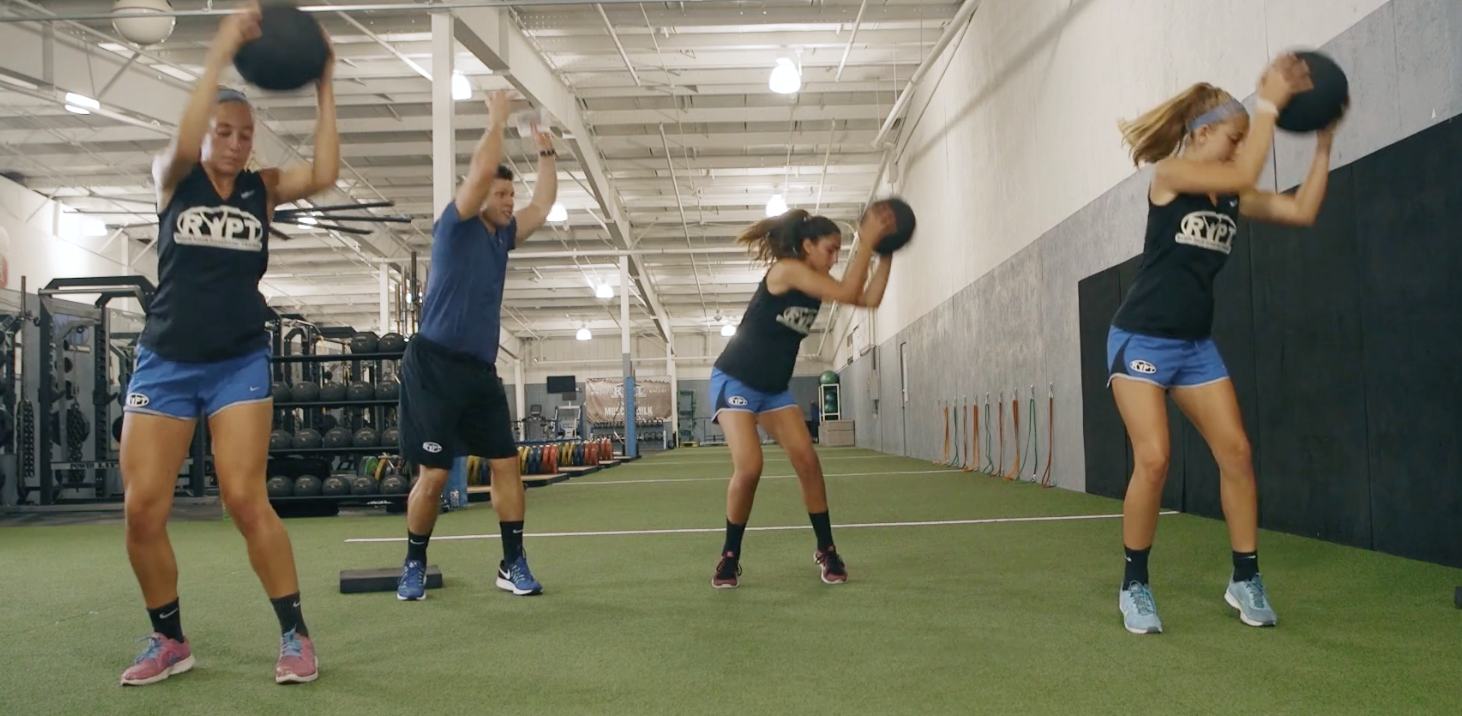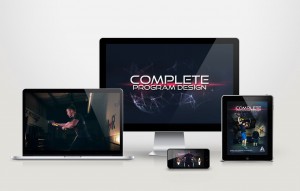Athletes are built from the inside out

Your core, pelvis and hips are the centerpiece of your athletic development. Chances are if you want to become a better athlete, spending some dedicated time focusing on this area will pay dividends.
But just saying you need to train that area is incredibly vague. What do we need to train exactly?
Your hips, being a ball and socket joint, have a ton of freedom of movement. But they are also surround by big muscles like your glutes, quads, and hamstrings, which are incredibly powerful to boot.
Quite simply, if you want to become the best athlete possible, you need to train mobility, stability and strength around your hips.
Let’s look at each of these qualities in a bit more depth, and then we’ll bring it all together with a programming template you can follow to become an absolute beast on the field or court!
Step #1 – Improve Mobility
Getting more mobility from your hips is a sure-fire way to improve your speed, strength, and power.
All of my athletes start by foam rolling the major muscle groups around the hips; this includes the glutes, TFL, quads, hamstrings, and groin. Just by getting these muscle groups to relax a bit will improve mobility and ROM, allowing you to more effectively load your hip muscles.
The next step is to improve your pelvic alignment. Now without going on a functional anatomy or biomechanics rant here, the big thing to focus on is improving stability and control over the pelvis.
If you’re an athlete, chances are you’re going to be in some degree of anterior tilt – and that’s ok. It’s not being in anterior tilt that’s the problem, so much as not being able to control your pelvic tilt that’s the problem.
If you’re locked in an anterior tilt, not only can you not posteriorly tilt the pelvis (which helps extend your hips), but you can’t flex your lower back, either.
And last but not least, if you're locked in anterior tilt, you're not going to be able to extend your hips effectively.
Even though it’s not a mobility fix, it’s imperative that you build a strong anterior core and abdominals on the front, as well as strong glutes and hamstrings on the backside of your body.
Last but not least, we have to remember that mobility and stability work hand in hand. While many are going to read this and work extensively on mobility, stability is every bit as important.
Step #2 – Improve Stability
Stability is the name of the game when it comes to being fast and explosive, especially when running or coming in and out of cuts.
Think about it like this – you’re sliding or shuffling to the right, and you plant your right foot to move back to the left.
But instead of hitting the ground and exploding back to the left, let’s imagine your foot, knee or hip is unstable. You get a little wiggle through your right knee.
This is why stability is important – if you can’t control the various joints in your body, you’re not going to be as strong or explosive as you should be. And, it could even predispose you to injury!
So how do we fix this?
In the weight room, this is the ideal time to incorporate split-stance and single-leg work in your programming.
The goal of single-leg and split-stance training is to work on stability and control. I cue my athletes to focus on maintaining a neutral spine, while also keeping their foot, knee and hip in alignment throughout the course of the exercise.
While numerous coaches want to push the weights on these types of exercises, the fact of the matter is you’ll never push as much weight on one leg as you can two. I’d much rather use them to improve stability and control, and I’ll leave the strength building to my big-bang exercises like squats and deadlifts.
(And if you want a real understanding of this, be sure to check out my FREE Single-Leg Training Video. It really is free!)
And speaking of strength and power, that’s the final thing we need to address.
Step #3 – Strength and Power
The goal of strength and power training is simple – to get STRONG(er) and/or more POWERFUL.
While this may sound incredibly simplistic at first, I’d beg you read it again and really take it to heart.
Too often, I see young athletes go in the gym and their doing the most exotic single-leg exercise on a Bosu ball or wobble board known to man.
Last time I checked, the best athletes in the world use the gym to get stronger.
They hang clean.
They squat.
They deadlift.
They press.
They chin.
I think sometimes we tend to get away from the basics, and it’s ultimately limiting out athletic development.
Taking this a step further, I put a ton of emphasis on developing the backside of my athletes. I don’t think I’ve ever seen an athlete that couldn’t’ stand to improve the strength of their glutes and hamstrings. Not only will this improve their pelvic position, but that of their lower back as well.
Last but not least, don’t forget the need for a strong and stable core. A strong and stable core helps properly align the pelvis, but by doing so improves mobility, stability and strength.
Bringing it All Together
So we need mobility, we need stability, and we need strength. How do we fit this all into one program?
At our gym, IFAST, we use what’s called the R7 approach to program design. Here’s how it might look:
R1 – Release
This is where you’d do your foam rolling and soft-tissue work. Focus on the big muscle groups like the glutes, quads, hamstrings and adductors.
R2 – Reset
This is where you’re trying to re-align your pelvis. We use specialized exercises here, but feel free to simply working on breathing for 3-5 minutes.
R3 – Readiness
This is where you’d work on mobility drills. Primary areas of focus are the ankles, hips, upper back and shoulders, but we spend extra time on the hips because of their importance.
R4 – Reactive
This is where you’d put your power exercises. If you’re comfortable with the Olympic lifts, use them.
If not, work on explosive exercises for the hips such as broad and vertical jumps, or various types of med ball throws.
R5 – Resistance
This is where you get in the gym and push some weight. I always start lower body workouts with either a squat variation or deadlift variation.
Once you’ve hit a big main exercise, then you start to fill in the gaps. Remember, your backside will never be strong enough so throw in some extra posterior chain work, as well as some single-leg or split-stance work.
Here’s a nice pool of exercises to start pulling from:
Squat | Deadlift | Supplemental Posterior Chain | Single-Leg | Split-Stance |
Goblet Squat | Trap Bar | Romanian Deadlift | Step-ups | Split-Squats |
Front Squat | Sumo | Ball Leg Curl | Squats | Lunges |
Back Squat | Conventional | Glute-Ham Raise | RDL’s | Half-Kneeling Exercises |
Make sure to finish off every strength training workout with some work for the anterior core and abdominals as well.
R6 – Resiliency
While you may not think of conditioning work as building your athleticism, the right conditioning exercises can make a huge difference.
Sure, if you’re just jogging or riding an exercise bike, that’s not going to get the job done.
But then again, that’s rarely the case with our programs!
Instead, focus on exercises that build the hips – Prowler pushes, tire flips, kettlebell swings and the like. Doing this will not only build your work capacity, but your explosiveness when you're fatigued as well.
R7 – Recovery
Finish your workout with some low-level breathing exercises. Banging out 10 deep breaths post-workout will help reset your ribcage and pelvic position, leaving you feeling better than when you walked in.
Summary
Mobility, stability, and strength – your hips really need it all.
If your goal is to become the best athlete possible, then you need to maximize your development on all three fronts.
Use the programming template I outlined above to make sure you cover all your training bases. I have no doubt it will make you a more dominant athlete going forward!
Stay strong
Mike Robertson
To discover the system that Mike Robertson uses to train his athletes, go here to learn more >>
Recommended Athletes' Acceleration
Products
—————————————————————————–




1 Comment for “Athletes are built from the inside out”